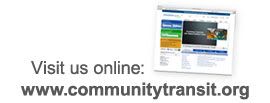Since April 1, ridership levels have remained steady at about 11,000 riders (29% of normal levels) each weekday, 7,500 (60% of normal levels) on Saturdays and 6,000 (67% of normal levels) on Sundays.
However, looking at our ridership levels map which compares February 2020 to April 2020, the decreases in ridership vary widely across our county. According to Roland Behee, Community Transit’s Director of Planning, the changes in ridership correspond to different ridership groups and the types of service available in each area.
 |
| Click to enlarge |
What routes have seen the lowest change in ridership?
Our Swift Bus Rapid Transit and rural routes have maintained the highest percentage of ridership. Prior on-board surveys and socioeconomic analysis have found that rural routes serve areas with limited travel options that can be supportive of transit ridership. Swift service, on the other hand, runs through areas of higher population density with many popular destinations along the corridors. We also know that many Swift riders in the past have reported that many do not own cars, so it remains a very convenient travel mode with more frequent service than other routes.
What about ridership on routes that connect to our core, higher-frequency service?
With the service reductions, Community Transit has tried to maintain service coverage so individuals in all of our communities can still use transit to meet their essential needs. Moreover, many of these routes allow transfers to and from our Swift service, which remains at almost 10-minute frequencies and provides access to some of the County’s most popular areas.
And what about commuter-focused routes to King County?
Since the University of Washington closed and many downtown Seattle workers have been asked to work from home, these routes have seen the biggest difference compared to normal ridership levels. Even now, though, we know people need to travel to fulfill their essential roles and we’re seeing approximately 425 riders per day traveling on these routes. It’s important to remember that we are accommodating for physical distancing on our buses and providing options for riders may not have any other way to get to their employment, go food shopping, or pick up their children from childcare. Moving forward we’re looking at options for service to match ridership demand while always keeping the safety of our customers and drivers as our number one priority.
---
Washington State’s phased reopening plan will likely result in incremental increases in transit use. Please subscribe to rider alerts or follow us on social media for updates about possible changes in service levels. For more information on our actions responding to COVID-19, please visit our dedicated page: Community Transit Coronavirus updates.






